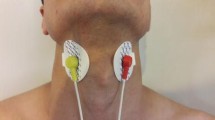Abstract
Paralysis of the structures in the head and neck due to stroke or other neurological disorder often causes dysphagia (difficulty in swallowing). Patients with dysphagia have a significantly higher incidence of aspiration pneumonia and death. The recurrent laryngeal nerve (RLN), which innervates the intrinsic laryngeal muscles that control the vocal folds, travels superiorly in parallel to the trachea in the tracheoesophageal groove. This study tests the hypothesis that functional electrical stimulation (FES) applied via transtracheal electrodes can produce controlled vocal fold adduction. Bipolar electrodes were placed at 15° intervals around the interior mucosal surface of the canine trachea, and current was applied to the tissue while electromyography (EMG) from the intrinsic laryngeal muscles and vocal fold movement visualization via laryngoscopy were recorded. The lowest EMG thresholds were found at an average location of 100° to the left of the ventral midsagittal line and 128° to the right. A rotatable pair of bipolar electrodes spaced 230° apart were able to stimulate bilaterally both RLNs in every subject. Laryngoscopy showed complete glottal closure with transtracheal stimulation in six of the eight subjects, and this closure was maintained under simultaneous FES-induced laryngeal elevation. Transtracheal stimulation is an effective tool for minimally invasive application of FES to induce vocal fold adduction, providing an alternative mechanism to study airway protection.








Similar content being viewed by others
References
Martino R, Foley N, Bhogal S, et al. Dysphagia after stroke: incidence, diagnosis, and pulmonary complications. Stroke. 2005;36:2756–63. doi:10.1161/01.STR.0000190056.76543.eb.
Medda BK, Kern M, Ren J, et al. Relative contribution of various airway protective mechanisms to prevention of aspiration during swallowing. Am J Physiol Gastrointest Liver Physiol. 2003;284:G933–9. doi:10.1152/ajpgi.0 0395.2002.
Heuschmann PU, Kolominsky-Rabas PL, Misselwitz B, et al. Predictors of in-hospital mortality and attributable risks of death after ischemic stroke: The German Stroke Registers Study Group. Arch Intern Med. 2004;164:1761–8. doi:10.1001/archinte.164.16.1761.
Troche MS, Okun MS, Rosenbek JC, et al. Aspiration and swallowing in Parkinson disease and rehabilitation with EMST. Neurology. 2010;75:1912–9. doi:10.1212/WNL.0b013e3181fef115.
Blitzer A, Brin MF, Ramig LO. Neurologic disorders of the larynx. 2nd ed. Berlin: Thieme; 2009.
Peckham PH, Knutson JS. Functional electrical stimulation for neuromuscular applications. Annu Rev Biomed Eng. 2005;7:327–60. doi:10.1146/annurev.bioeng.6.040803.140103.
Burnett TA, Mann EA, Cornell SA, Ludlow CL. Laryngeal elevation achieved by neuromuscular stimulation at rest. J Appl Physiol. 2003;94:128–34.
Broniatowski M, Moore NZ, Grundfest-Broniatowski S, et al. Paced glottic closure for controlling aspiration pneumonia in patients with neurologic deficits of various causes. Ann Otol Rhinol Laryngol. 2010;119:141–9.
Shaw DW, Cook IJ, Gabb M, et al. Influence of normal aging on oral-pharyngeal and upper esophageal sphincter function during swallowing. Am J Physiol. 1995;268:G389–96.
Hadley AJ, Kolb I, Tyler DJ. Laryngeal elevation by selective stimulation of the hypoglossal nerve. J Neural Eng. 2013;10:046013. doi:10.1088/1741-2560/10/4/046013.
Sanders I, Aviv J, Biller HF. Transcutaneous electrical stimulation of the recurrent laryngeal nerve: a method of controlling vocal cord position. Otolaryngol Head Neck Surg. 1986;95:152–7.
Sun SQ, Zhao J, Lu H, et al. An anatomical study of the recurrent laryngeal nerve: its branching patterns and relationship to the inferior thyroid artery. Surg Radiol Anat. 2002;23:363–9. doi:10.1007/s00276-001-0363-9.
Sanders I, Kraus WM, Aviv JE, et al. Transtracheal/transesophageal stimulation of the recurrent laryngeal nerve. Laryngoscope. 1987;97:663–7. doi:10.1288/00005537-198706000-00002.
Kraus WM, Aviv JE, Sanders I, Biller HF. Laryngeal electrode platform: an indwelling device for mobilizing the vocal cords. Ann Otol Rhinol Laryngol. 1987;96:674–9.
Sercarz JA, Berke GS, Rothschiller J, Ming Y. Fabrication of a custom electrode endotracheal tube. Laryngoscope. 1991;101:1024–5. doi:10.1288/00005537-199109000-00018.
Broniatowski M, Vito KJ, Shah B, et al. Contraction patterns of intrinsic laryngeal muscles induced by orderly recruitment in the canine. Laryngoscope. 1996;106:1510–5. doi:10.1097/00005537-199612000-00013.
Rattay F. Modeling the excitation of fibers under surface electrodes. IEEE Trans Biomed Eng. 1998;35:199–202. doi:10.1109/10.1362.
Humbert IA, Poletto CJ, Saxon KG, et al. The effect of surface electrical stimulation on vocal fold position. Laryngoscope. 2008;118:14–9. doi:10.1097/MLG.0b013e318155a47d.
Liebermann-Meffert DM, Walbrun B, Hiebert CA, Siewert JR. Recurrent and superior laryngeal nerves: a new look with implications for the esophageal surgeon. Ann Thorac Surg. 1999;67:217–23.
Tyler DJ, Durand DM. Alteration of neural geometry for selective nerve stimulation. Proc Annu Int Conf IEEE Eng Med Biol. 1997;5:2002–3.
Sanders I, Wu B-L, Mu L, et al. The innervation of the human larynx. Arch Otolaryngol Head Neck Surg. 1993;119:934–9.
Nishino T, Kohchi T, Yonezawa T, Honda Y. Responses of recurrent laryngeal, hypoglossal, and phrenic nerves to increasing depths of anesthesia with halothane or enflurane in vagotomized cats. Anesthesiology. 1985;63:404–9.
Kochi T, Hagiya M, Mizuguchi T. Effects of enflurane on contractile response of canine trachealis muscle. Anesthesia Analgesia. 1989;69:60–8.
Acknowledgments
This work was funded by a Grant from the Coulter Foundation through the Case-Coulter Translational Research Partnership.
Conflict of interest
D. J. Tyler has an equity stake in Bear Software, LLC, which has commercial interest related to subject matter discussed in the article. P. Thompson, I. Kolb, E. C. Hahn, and D. J. Tyler have no conflicts of interest or financial ties to disclose.
Author information
Authors and Affiliations
Corresponding author
Rights and permissions
About this article
Cite this article
Hadley, A.J., Thompson, P., Kolb, I. et al. Targeted Transtracheal Stimulation for Vocal Fold Closure. Dysphagia 29, 346–354 (2014). https://doi.org/10.1007/s00455-014-9517-x
Received:
Accepted:
Published:
Issue Date:
DOI: https://doi.org/10.1007/s00455-014-9517-x




